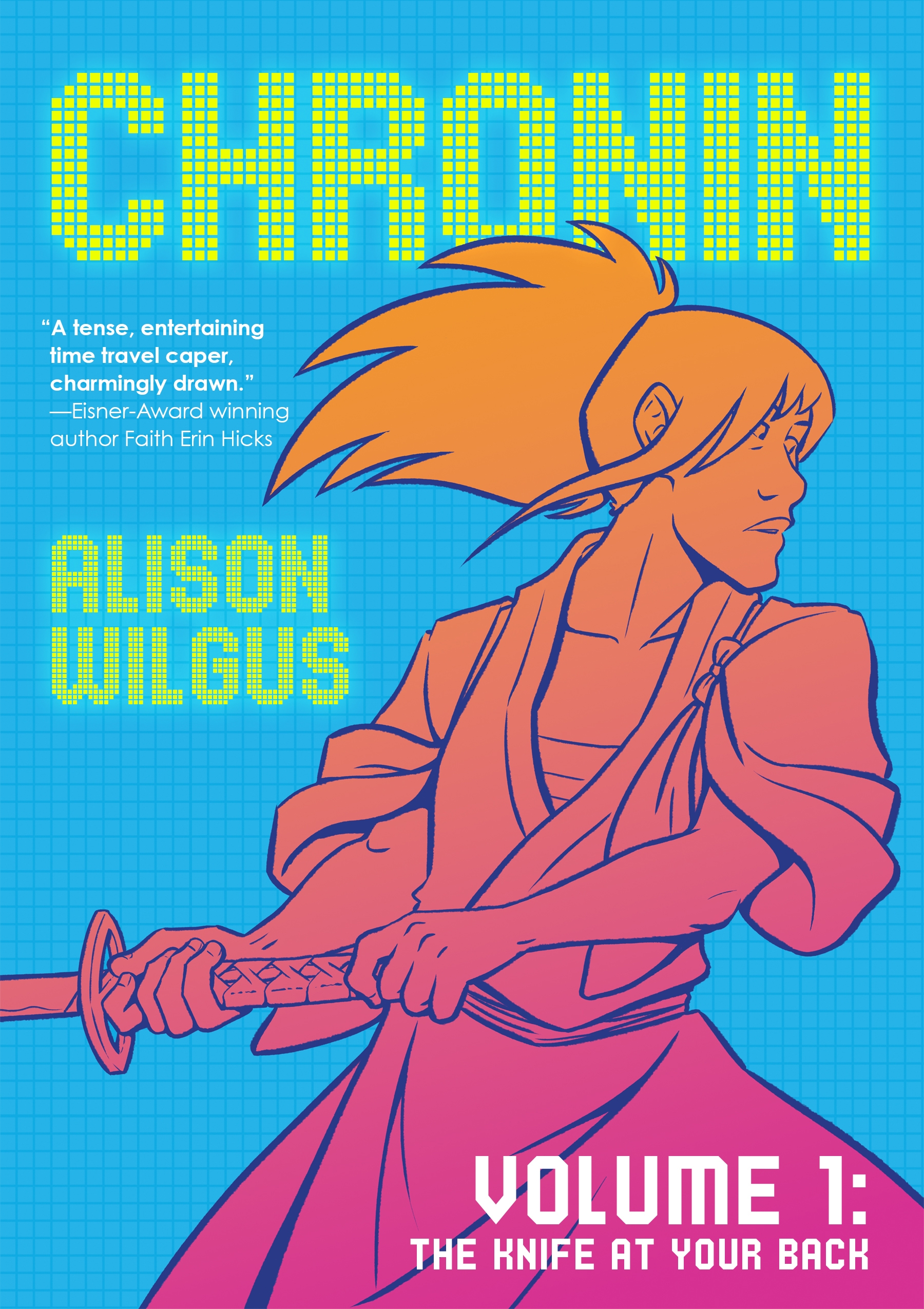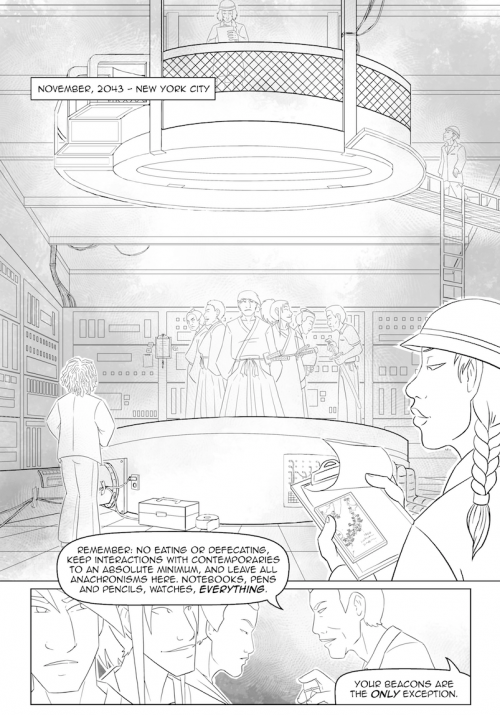 Alison Wilgus is joining us today with her graphic novel Chronin Volume 1: The Knife at Your Back. Here’s the publisher’s description:
Alison Wilgus is joining us today with her graphic novel Chronin Volume 1: The Knife at Your Back. Here’s the publisher’s description:
2042, New York City: A day in the life of college student Mirai Yoshida means studying Japanese history, learning swordmanship, flirting with her TA, and preparing to travel to Japan in 1864. Everything changes once she goes back to the past. Mirai and her classmates are ambushed by rebel samurai. Her friends are killed, her time travel machine is lost, and Mirai ends up marooned. In order to survive, she disguises herself as a wandering samurai and is hired by Hatsu, a tea waitress, as bodyguard for her travels. Mirai has to find her way back to the future soon, or else she may be the first casualty on the bloody front lines of a conflict that is destined to shape a nation
What’s Alison’s favorite bit?

ALISON WILGUS
I love time travel stories with all my heart and I make no apologies. I was enthralled with the Back to the Future series as a child, and ever since I’ve been a ravenous consumer of time travel fiction and returned to it as a narrative device over and over again in my own stories. It was not a surprise to anyone who knows me that my first major work of solo fiction has a time machine at its heart.
There are many different kinds of time travel stories, featuring wild variations of mechanic and conceit. Plot-wise, Chronin is a “trapped in the past” type with academic interest as the “why,” which puts me squarely in the Connie Willis school. Regarding timeline logistics, I went with “parallel worlds” — one cannot travel into one’s own past directly, only to the past of a near-identical universe. And the tech? Absolutely shameless “don’t worry about it” handwaving.
As for why our main character, Mirai Yoshida, is personally hurling herself backward through time?
Because she’s a major in Time Travel Studies at a fictional Manhattan university.
As a high school student in Eastern Massachusetts, I was taken on a Physics field trip to visit the Alcator C-Mod tokamak fusion reactor at MIT. This was something like twenty years ago, but I have a vivid memory of walking into a cramped round room mostly occupied by the reactor itself. And I remember, in particular, how haphazard it felt — how it gave me the impression of being held together with chewing gum, duct tape, and hope.

About a decade later, when designing the “Time Machine Room” for Volume 1 of Chronin, I tried to capture that same feeling — of a machine built by grad students and maintained by TAs, of a technology in its early years at a well-funded research university. I wanted the time travel in Chronin to feel a little dangerous — right at the edge of what you’d allow a living person to use, but maybe only after they’d signed a thick stack of forms. We see Mirai laboring through her thorough study of history, see her shepherded by cautious professors and warned of the dangerous responsibilities which she and her classmates have been given. We are told through the mouths of that same faculty how she’s in rarefied company; that hers is the first undergraduate class that will be allowed to access this machine.

The thing is, all time travel stories are built on a foundation of bullshit — it’s inevitable, because unless you’re writing an extremely strict no-free-will-closed-loop kind of a tale, the logic of even the cleverest mechanism will fall apart under sufficient scrutiny. So all you can do is treat your time travel like a science fantasy magic system and attempt, as much as possible, to address the concerns of consistency and justify your basic premise.
When I tell people the plot of this book, I’m often asked why anyone in their right mind would give college students access to a time machine in the first place. And hey, fair question! I can’t speak for everyone, but I was personally an impulsive idiot when I was in my early twenties.
As I revised and rewrote and refined my manuscript over the years, the solution I honed in on was fairly straightforward: the Time Travel Studies program would be framed as highly selective and prestigious, and also very, very new. New enough to still be in those early years of high ignorance and low regulation, the kind of technological bleeding edge which gave us clothing dyed green with arsenic and radioactive patent medicine. The sparkling debut of an experimental department at an elite New York City university….right before it learns some hard lessons via the misfortunes of its students and staff.
If I’m honest, I have a hundred favorite bits of this story — that happens a lot in comics, as you’re chiseling away at them for years and years and have to trick yourself into sticking with it through single-minded over-investment. But way up there in the hierarchy was building a time travel school which felt believable enough for me to care about, but which would also plausibly have sent Mirai Yoshida — a student barely old enough to drink — backwards in time with a sword shoved in her belt.
LINKS:
Chronin v1: The Knife at Your Back Universal Book Link
BIO:
Alison Wilgus is a Brooklyn-based bestselling writer, editor and cartoonist who’s been working in comics for over a decade. Most of her professional work has been writing for comics, including two works of graphic non-fiction with First Second Books about aviation history and human spaceflight. Her short prose fiction has been published by Interzone, Analog and Strange Horizons. Her latest work is Chronin, a science-fiction duology from Tor books and her solo graphic novel debut. In her spare time, she co-hosts a podcast about comics publishing called “Graphic Novel TK” with Gina Gagliano.
